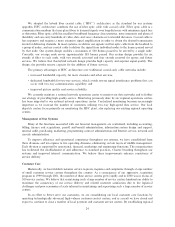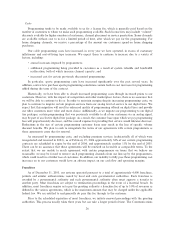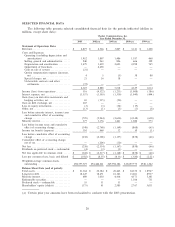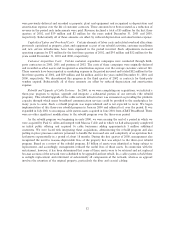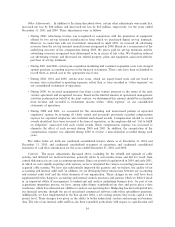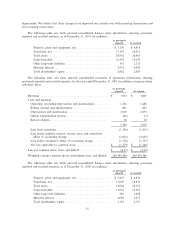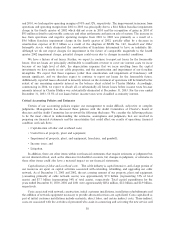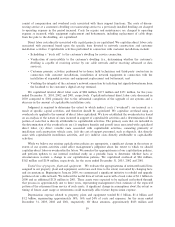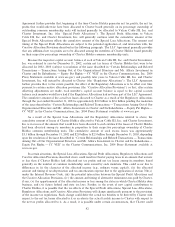Charter 2003 Annual Report Download - page 36
Download and view the complete annual report
Please find page 36 of the 2003 Charter annual report below. You can navigate through the pages in the report by either clicking on the pages listed below, or by using the keyword search tool below to find specific information within the annual report.Other Adjustments. In addition to the items described above, certain other adjustments were made that
increased net loss by $38 million and decreased net loss by $10 million, respectively, for the years ended
December 31, 2001 and 2000. These adjustments were as follows:
‚ During 2000, advertising revenue was recognized in conjunction with the promotion of equipment
oÅered by two set-top terminal manufacturers from which we purchased digital set-top terminals.
However, in connection with our restatement announced in April 2003, we reversed all advertising
revenues from the set-top terminal manufacturers recognized in 2000. Based on a reassessment of the
underlying structure of the arrangements during 2000, the prices paid for set-top terminals and the
advertising revenues recognized were determined to be in excess of fair value. We therefore reduced
our advertising revenue and decreased our related property, plant and equipment associated with the
purchase of set-top terminals.
‚ During 2001 and 2000, certain post-acquisition marketing and customer acquisition costs were charged
against purchase accounting reserves in the Ñnancial statements. These costs have been reclassiÑed to
record them as period cost in the appropriate Ñscal year.
‚ During 2002, 2001 and 2000, certain state taxes, which are equity-based taxes and not based on
income, were reclassiÑed as operating expenses, rather than as taxes recorded in ""other expenses'' on
our consolidated statements of operations.
‚ During 2000, we received management fees from a joint venture pursuant to the terms of the joint
venture agreement and recognized revenue. Based on the limited amount of operational management
activities performed on behalf of the joint venture, we determined this amount should be reclassiÑed
from revenue and recorded as investment income within ""other expense'' on our consolidated
statements of operations.
‚ During 2000 and 2001, we accounted for the outstanding and unexercised portion of separated
employees' options by reversing all (both vested and unvested) previously recorded compensation
expense for separated employees who forfeited stock-based awards. Compensation related to vested
awards should not have been reversed at the time of separation, as the employee did not ""fail to fulÑll
an obligation'' associated with such vested awards. Stock compensation expense was increased to
eliminate the eÅect of such reversal during 2000 and 2001. In addition, the computation of the
compensation expense was adjusted during 2000 to reverse a miscalculation recorded during such
years.
The tables below set forth our condensed consolidated balance sheets as of December 31, 2001 and
December 31, 2000, and condensed consolidated statement of operations and condensed consolidated
statement of cash Öows information for the years ended December 31, 2001 and 2000.
Controls. The major adjustments discussed above, including for the rebuild and upgrade of cable
systems and deferred tax matters/franchise, generally relate to non-routine items and did not result from
control deÑciencies in our core accounting operations. Since our period of rapid growth in 2000 and early 2001,
in which we were rapidly acquiring cable systems, we have integrated the various accounting processes of our
acquired cable systems. We have also substantially improved the quantity and, we believe, the quality of our
accounting and internal audit staÅ. In addition, we are developing better interactions between our accounting
and internal audit staÅ and the other elements of our organization. These changes in our staÅ have been
supplemented with changes in accounting and internal controls processes and systems which we believe result
in an improved ability of management to understand and analyze underlying business data. As part of our
acquisitions integration process, we have, among other things, standardized our data and put in place a data
warehouse, which has enhanced our abilities to analyze our operating data. Budgeting has been integrated into
our Ñnancial systems, through the use of specialized commercial software rather than spreadsheet programs.
Additionally, we have implemented in the Ñrst quarter 2004, a job costing system, that tracks capital at the
project level. These changes have given us the ability to better understand, analyze and manage our business
data. The role of our internal audit staÅ has also been expanded, particularly with respect to capitalization and
34


